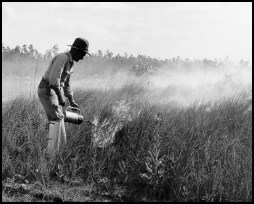
The Organic Act of 1916 not only established the National Park Service, but also described the basic objectives of the Service in managing park units. The preservation objectives were interpreted to mean that humans should not interfere with these land areas, and should protect them from processes such as fire, which would damage the natural resources. The preservation objectives led to the policy of fire exclusion, where all fires were actively suppressed. Everglades National Park was the first to use prescribed fire to maintain biological diversity. The park was dedicated in 1947, and early fire management actions were aimed at total suppression of wildland fires. A series of dry years in the 1950s resulted in great efforts in controlling the prevalent fires. Although fire was seen as a major force in shaping the Everglades, too much fire was destroying it. In 1958, a study was initiated to determine the role of fire in Everglades National Park. The study concluded that in order to preserve certain ecosystems, active fire management was needed. As a result of the 1958 study, the first prescribed fire ever in a national park unit was conducted in Everglades National Park. The objectives were to reintroduce fire in a controlled manner to minimize damaging effects and perpetuate the fire-adapted pine forest community of the park. To maintain its biological diversity, fire is a necessary part of Everglades National Park. |
Last updated: September 3, 2015
